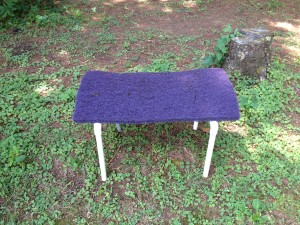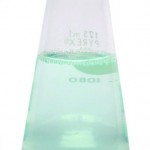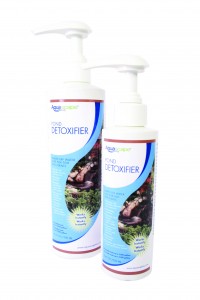Aquascape Pro and the Aquasurge - Clearing the Clog
 June 16th, 2011
June 16th, 2011
 PondMeister
PondMeister
The Aquasurge pumps are a great replacement for the old Aquascape Pro pumps at low head heights and at or below 5000 gph. They are much less expensive up front, much more energy-efficient, have a 3 year vs a 2 year warranty and do not need to be kept in water when removed for the winter.
For example, currently the Aquascape Pro 4500 costs $579, takes 625 watts ($45.60/Month), has a 2 year warranty and pumps 4500 gph at 5′. Compare that to the Aquasurge 5000 which costs $415, consumes only 250 watts ($18.24/Month), has a 3 year warranty and gets out 4,280 gph at 5′
There are a few differences between the Aquasurge and the old Aquascape Pro pumps however.
As the Head Height becomes higher the disparity becomes greater between the 2 pumps. At 15′ of head height (head height is the vertical distance from WATER LEVEL to the top of the waterfall PLUS 1′ for every 10′ of horizontal distance), the Aquascape Pro4500 gets out 3300 gph compared to only 2377 for the Aquasurge 5000.
Also, the Aquascape Pro pumps were more solids handling pumps than the Aquasurge and have that 1″ opening that can swallow and spew pieces of stuff out to the Biofalls. The Aquasurge is not as much of a solids-handling pump and the cage seems to protect the pump..but at the same time, catch a lot of debris that can choke the pump from getting water.
I have 3 different skimmers – each with an Aquasurge 5000. Two of the three, I have to clear the cage at least every week or two. I can always tell when the flow slows down that it’s time to clear the cage. My filter mats on my 3rd skimmer fit very tightly and very little debris gets thru to the pump so I rarely have to clear that cage. Moral of the story – make sure your mats fit snugly and remember to keep a watch on the cage and make sure it stays cleared.
Lastly, the Aquascape Pro pumps have much more power to force water up or thru pipes that may be too small than ideal. We have had several customers who had pipes that were smaller than 2″ and the Aquascape pros were able to force more water thru than the corresponding Aquasurge pumps.


 Pond Products, Pond Tips | 2 Comments »
Pond Products, Pond Tips | 2 Comments »
Uh-oh - Sliced my Liner!
 June 14th, 2011
June 14th, 2011
 PondMeister
PondMeister
Question of the day (from Brian K): I accidentally made a vertical slit in the liner about 8″ to the left of the skimmer. The slit goes from about 4″ from the bottom all the way to the top. I was about to make another slit to the right of the skimmer so i could pull the liner out to aid in attaching the liner to the skimmer when i realized my mistake. How can i patch this slit…my thought was black silicon and a piece of liner.
Aquascape Tech (Fred) Answer: Unfortunately silicone and liner will not make a watertight connection. The correct way would be to use our EPDM primer and seam and/or cover tape to put it back together. The EPDM primer will prepare the liner to accept the seam/ cover tape. It sounds like cover tape (one sided tape) would work in your situation. If done correctly that will make a water tight seal and get you back in business.
Editors Note: OK – the video is in German and is from OASE who pulled out of the US Market two years ago but you get the picture
 Pond Tips | Comments Off on Uh-oh - Sliced my Liner!
Pond Tips | Comments Off on Uh-oh - Sliced my Liner!
Aquascape's EcoBlast - Effective against String Algae
 June 5th, 2011
June 5th, 2011
 PondMeister
PondMeister
Dave Kelly – Aquascape’s Tech Guy – discusses EcoBlast which has been proven to be very effective against string algae. If you already have a growth of string algae in the spring, we have found it most effective to apply every 3 days for 2 – 3 weeks until you are in control and then drop back to once a week for the remainder of the summer. Use about 4 ounces per 1000 gallons and don’t forget to turn off your pump for an hour after applying to a stream or waterfall.
If you are concerned about applying an algaecide and want to absolutely eliminate all of the string algae, please check out the IonGen.
 Pond Products, Pond Tips | 2 Comments »
Pond Products, Pond Tips | 2 Comments »
First Review on "Pond Monsta" Pond Vacuum
 May 28th, 2011
May 28th, 2011
 PondMeister
PondMeister
We just got our 1st review from Josh H from Texas on the Pond Monsta pond vacuum. Enjoy.
“The Monsta Vac has got some Balls to it. It really moves the water, which is what I think the complaints from many pond vac people were saying they had with other vacs.
I would like to see a tighter mesh netting for the catch bin, currently the netting that’s being used will only catch large item like leaves, but can easily be resolved by implementing your own tighter knit netting which is what I did.
Also, an additional hose extension as an option for people like me with a fairly large pond.
I coupled a cleanout hose we have, so I was able to make it work, but I can see others having the same issue.
The concept of the Vac seems good, push the water, not to try to above ground vacuum (pull) the water.
And like I said, it has some balls to it, it really moves the water.
You had asked me before to write you to let you know how I liked it.”
 Pond Products | Comments Off on First Review on "Pond Monsta" Pond Vacuum
Pond Products | Comments Off on First Review on "Pond Monsta" Pond Vacuum
Pond & Landscape LED Light Kit by Aquascape
 May 28th, 2011
May 28th, 2011
 PondMeister
PondMeister
We are big fans of these energy efficient lights from Aquascape. You can find them on our site with this link: LED Light Kit.
Dave Kelly, The Tech Guy, walks us through the values and benefits of our new Pond & Landscape LED Light Kit. This light kit was designed with the consumer in mind as it is pre-wired and immediately ready for installation. Just plug it in and you are ready to go. (Each of these lights are equivalent to the old 10 watt halogen lights)
 Pond Products | 1 Comment »
Pond Products | 1 Comment »
Troubleshooting Pump Problems from Aquascape
 April 14th, 2011
April 14th, 2011
 PondMeister
PondMeister
 The pond pump is one of the most important pieces of equipment in your customer’s pond, and it’s good to know how to take care of it in case your customers have questions. Oftentimes, pumps burn out or die prematurely due to improper care and installation. By informing your customer how to take care of their pump, you can ensure it will last several years.
The pond pump is one of the most important pieces of equipment in your customer’s pond, and it’s good to know how to take care of it in case your customers have questions. Oftentimes, pumps burn out or die prematurely due to improper care and installation. By informing your customer how to take care of their pump, you can ensure it will last several years.
Issue: Pump Hums but Pushes Very Little Water
Possible Cause: Impeller may be seized by debris
Troubleshooting: Unplug and remove the pump from the pond and inspect the pump intake to ensure there is no debris restricting the impeller. Remove any debris, like rocks or sticks, which may have become lodged around and above impeller.
While the pump is still out of the pond, lay it on its side and plug in the pump to see if the impeller spins. If the impeller does not spin, use a screwdriver or similar tool to kick start the impeller.
Possible Cause: Pump may be air-locked.
Troubleshooting: Air has gotten into the impeller chamber. Tilt the pump while it’s in the pond to allow air to be released from the chamber or remove the pump from the pond and re-install, ensuring that the impeller chamber is flooded with water.
Issue: Pump Pushes Very Little Water
Possible Cause: Plumbing clogged with debris.
Troubleshooting: Disconnect the pump from the pipe. This will allow the plumbing to drain. Clogged debris may back-flush out of the plumbing and into the pond during this procedure. Inspect the plumbing to make sure no debris is lodged inside.
Issue: Pump Is Not Running
Possible Cause: Poor electrical connection, tripped breaker, blown fuse, or other interruption in power supply.
Troubleshooting: Check to make sure all electrical connections are working and that a qualified electrician installed and tested it. Note – Long extension cords may cause voltage drop at the pump and the amps to rise above maximum level. This can cause the pump to heat up and burn out the motor.
Issue: Pump Operates Intermittently
Possible Cause: Not enough water in the pond.
Troubleshooting: Most pumps must be submersed in water to operate properly. Low water levels may cause the pump’s internal thermal shut-off to activate. The thermal shut-off will deactivate once the pump is cooled down. The proper water level must be established in the pond for the pump to work properly.
Possible Cause: The pond is too small to support the volume of water needed for the stream.
Troubleshooting: The pond must be designed to provide enough water to the stream and waterfalls for proper circulation. When the pump is first started, it may be necessary to add a few inches of water to the pond in order to account for the water used to feed the stream and waterfalls. Upper pools and “check” dams in the streams are also very effective at holding water upstream when the pump(s) are not operating. Ponds that are too small may not be able to supply enough water to start the streams and waterfalls. This will cause the water in the pond to drop below the opening of the skimmer upon initial start-up and starve the pump of water.
Just Enjoy!
Remember, your customer’s pond should not be an endless source of frustration and confusion. But do remind them that routine, general maintenance needn’t be a burden. After all, how many tasks do they (or you, for that matter) get to perform in the warm sun, with the sounds of frogs and birds all around with friendly koi nibbling at fingers? Enjoy it!
 Pond Tips | 33 Comments »
Pond Tips | 33 Comments »
My Grande Skimmer has no Filter Mat. Say What?
 April 6th, 2011
April 6th, 2011
 PondMeister
PondMeister
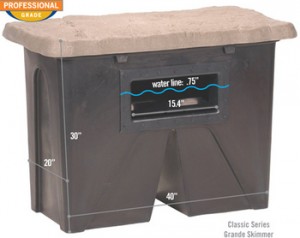 I always wondered why my 6,000 gallon pond with a Grande Skimmer and Grande BioFalls (The largest Skimmer and BioFalls Aquascape makes) was never as clear as my 3,000 gallon pond with the Standard Large Classic Skimmer and the Standard BioFalls.The only difference had to be the fact that my Grande Skimmer had a Debris Net but no Filter Mat while my Standard Skimmer had both.
I always wondered why my 6,000 gallon pond with a Grande Skimmer and Grande BioFalls (The largest Skimmer and BioFalls Aquascape makes) was never as clear as my 3,000 gallon pond with the Standard Large Classic Skimmer and the Standard BioFalls.The only difference had to be the fact that my Grande Skimmer had a Debris Net but no Filter Mat while my Standard Skimmer had both.I though my contractor had messed up and failed to leave me a mat.I tried to find out so I went to several chat rooms and had three different “Experts” give me part numbers for the correct Filter Mat which all turned out to be bogus. The answer was “None of the Above”. The Grande Skimmer was purposely designed without a Skimmer Mat I am told because of the fear of a huge pump sucking in the mat.
The ramifications of no mat however was that all the skimmer was “filtering” was what the Debris Net could catch and not much else. The whole purpose of a Skimmer is to do the Mechanical Filtrationwhich is to catch the “pieces of stuff” while allowing the BioFalls to do the Biological Filtration and convert the fish waste into Beneficial Bacteria. You only want to clean a BioFalls once a year as to not disturb the colonies of Beneficial Bacteria – especially with the Gi-normous Grande Biofalls which is HUGE and a really nasty job to clean.The result was a ton of debris ending up in the BioFalls rather than being caught by the skimmer.
After discussing the situation and my observations a few years ago with one of Aquascape’s crack Tech staff, they made a very simple schematic of a Grande Skimmer Rack that could be made in minutes out of PVC pipe to elevate the filter mat above the pump(s) at the bottom of the skimmer and below the debris net and – Voila – I had a fully functioning Skimmer that actually filtered a lot of that annoying small particle matter that gives the pond a cloudy look.
Here are a couple of links to the mats you can use (I actually use 2 mats in mine) the 2″ thick Poly-Flo Fusion Flow Purple Filter Material (AMEFF) on top of the rack which is very rigid and insures that the Filter Mat is not sucked into your pumps and then a 1″ thick dense White Filter Material (AMEJC1) on top of the Purple mat to catch some of the smaller particles.. I can even put in one of our new “Party-Pack Filter Mats” temporarily if I really want to clear up the water using a flocculant like Aquascape’s RapidClear .
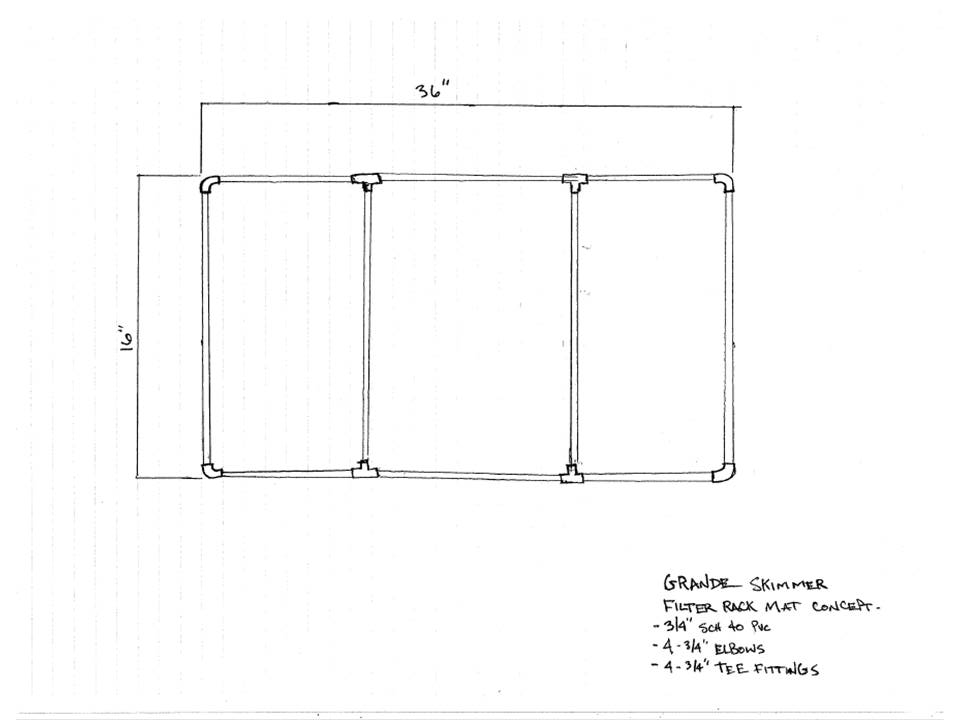
 Pond Tips | 14 Comments »
Pond Tips | 14 Comments »
Announcing the new "Party-Pack Filter Mat"!
 April 3rd, 2011
April 3rd, 2011
 PondMeister
PondMeister
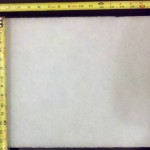 Need to clear up that pond fast for the Big Party this week-end?
Need to clear up that pond fast for the Big Party this week-end?
ThePondOutlet.com offers the new “Party-Pack Filter Mat” designed expressly for clearing up your pond NOW. Designed for short-term use to immediately clear up the pond.
Place in the skimmer or in front of the skimmer or anywhere the water passes through. (If placed in front of the skimmer, be sure to keep an eye on it as it traps so many particles that it may fill up quickly and clog your pump).
Once it fills up with particles and debris and turns dark, simply hose off and re-use.
Best used in conjunction with any Pond Flocculant or clarifier such as RapidClear by Aquascape.
These products are designed to clump suspended debris which can then be easily removed by the Party-Pack Filter.
- 15″ x 17″ 2″
- Compressed Polyester
- Re-usable and washable
 Pond News | 1 Comment »
Pond News | 1 Comment »
Should I do an Annual Pond Clean-out?
 April 3rd, 2011
April 3rd, 2011
 PondMeister
PondMeister
Just got this question today:
Customer John K’s Question:
I am sorry to keep bothering you but I am new to having a pond. On your website you recommend California wetscapes and their checklist says they remove the fish which we have already done. Then they pump all the water out of the pond, pressure spray the pond clean and then refill it. Would you recommend this? My pond was new last year, it has a few plants and got some mulch in it from the landscaping around it during the winter. Now it has been running for a few days in 40 – 50 degree weather and it has foam all over it. It is about a 4000 gallon pond. I have no problem draining and refilling it and would not mind pressure spraying it out, but I do not want to do this if it is not necessary.
PondMeister Answer:
I hope your landscapers did not use any fertilizers or poisons around the yard where the pond is. The slightest leaching can wreak havoc with the pond. If you need to fertilize anything back there, use pond water – it’s the best fertilizer EVER.
I am a big fan of annual clean-outs. All the debris that settles at the bottom is a haven for algae and other bad things. Best to start over. Make sure you de-chlorinate the water before you put the fish back in. Try to retain as much of the old water as possible. The guy who does my 6,000 gallon pond each year has 3 – 1,000 gallon temporary tanks so we can keep a large portion of the water and not stress the fish too much.
Below is Aquascape’s Official Instructions to their Contractor’s for Pond Clean-outs
Spring clean outs are usually done early spring, before your pond awakens from it’s winter dormancy. Clean outs should take place before water reaches 55°F.
Things you’ll need:
- Container to hold fish and frogs
- Fish net
- Five gallon buckets to collect leaves and debris
- Old clothes (You’re going to get dirty)
- Gloves
- 25’ of 1.5” or 2” discharge piping
- Sump pump with a screen or skimmer pump with chicken wire around it
- High pressure nozzle for your garden hose or power washer
- Garden shears (for trimming plants)
Steps for successful clean out:
- Begin draining pond. Use your pump with chicken wire or screen around it to help protect fish from being sucked in. Use some of this water for the container to house fish in. Also make sure you move the piping around a few times so all the water doesn’t go in one place. (This water is excellent for fertilizing plants.)
- When water level reaches about six inches, turn pump off and catch fish. (It’s a waste of time to try and catch then when pond is full!) Place fish in container and make sure to cover if you have Koi because they do jump.
- Once fish and others are in container, begin hosing down rocks and gravel.
- A high-pressured nozzle or power washer should be used for hosing down rocks. Don’t wash away all algae because a little bit will be beneficial in developing your ecosystem. (For an average size pond, 11’x16’, this takes about 15 minutes.)
- Take this opportunity to trim back any plants that appear to be overgrown.
- The most time consuming part will be washing the debris off your rocks and gravel. DO NOT use the power washer for this; use the water coming out of the garden hose. Keep pump plugged in, water and sediment will go to the deepest part of the pond so it will be able to get sucked out.
- Clean out skimmer box by sucking out water and hosing down. Clean out net and filter pad too.
- Clean your BIOFALLS mats and lava rock by hosing them down until they’re clear.
- Now that the pond is pretty much cleaned out, remove the pump and begin filling the pond. Once your pond is half full you can begin to reintroduce your fish and plants.
- Remember…if you’re using city water, you need to use a de-chlorinator such as Pond Detoxifier from Aquascape. Chlorine will kill fish. Add the appropriate amount of de-chlor so you can start adding fish. Dip your buckets into the holding tank and fill them with a few inches of water. Add your fish and float the buckets in the new water.
- After around 15 minutes, begin splashing pond water into the bucket. By now temperatures should be close to the same (pond water and bucket water). You can now add fish into pond.
- It’s very important at this point to add Beneficial Bacteria to “jump-start” the ecosystem in the pond. If the WATER temperature is between 45 and 55 degrees, use Cold Water Beneficial Bacteria from Aquascape and if the water temperature has already warmed up over 55 degrees, use either Beneficial Bacteria for Ponds – Dry or Beneficial Bacteria for Ponds – Liquid.
Note: Clean out should be done in timely fashion. Fish are weak in the spring. They shouldn’t be kept in full sunlight or in container outside of pond for more than a few hours.
 Pond Tips, Questions and Answers | 12 Comments »
Pond Tips, Questions and Answers | 12 Comments »
The BEST way to kill your fish!
 April 1st, 2011
April 1st, 2011
 PondMeister
PondMeister
I get at least one call a week from a customer who has re-filled his pond with tap water without de-chlorinating the water prior to putting the fish back in.
Scott Rhodes – Aquascape’s Product Guy – discusses the use of Aquascape’s Pond Detoxifier for the spring clean-out process and any other time you are re-filling your pond with tap water.
 Pond Tips | 2 Comments »
Pond Tips | 2 Comments »
